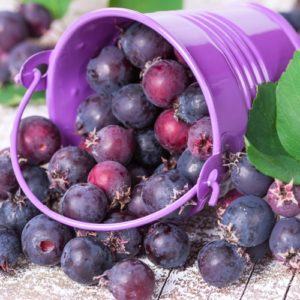
What is a saskatoon?
Saskatoon berries have a purplish-blue color. The berries were a staple food for Canadian aboriginals as well as early settlers. Saskatoon berries grow on a shrub, a plant of which many parts were once used for medicinal remedies. Surprisingly, these fruits are not actually berries–they are in the same family as apples and pears. These berries are in many ways a superfood, boasting high levels of protein and fiber, along with a slew of vitamins and antioxidants. Saskatoon berries have approximately three times more potassium than blueberries.
Interestingly enough, the flavor of these berries almost seems to be a matter of personal opinion. Saskatoons have been described as tasting similar to peaches, almonds or cherries, depending on who you talk to.
Cultivation in the U.S.
Saskatoons only seriously started being grown commercially in Michigan as recently as 2008. These fruits are now grown by around 20 farmers in the region, though the berries are considered a national product of Canada. Many Michigan residents started growing saskatoons because the hearty shrub can survive the cold. Cherry orchards in the region have been affected by unpredictable weather patterns, notably in 2012, when 97 percent of crops were lost due to cold temperatures. Though saskatoons will likely never replace the current cherry culture that thrives in the area, the berries could potentially give growers a safety net from unexpected weather conditions.
How to cook with saskatoons
Similar to other fruits, saskatoons are great for making pastries such as pies and cobblers. Use lemon to complement the sweet and nutty flavor of the berries. Saskatoons are also perfect for making jams and jellies.



